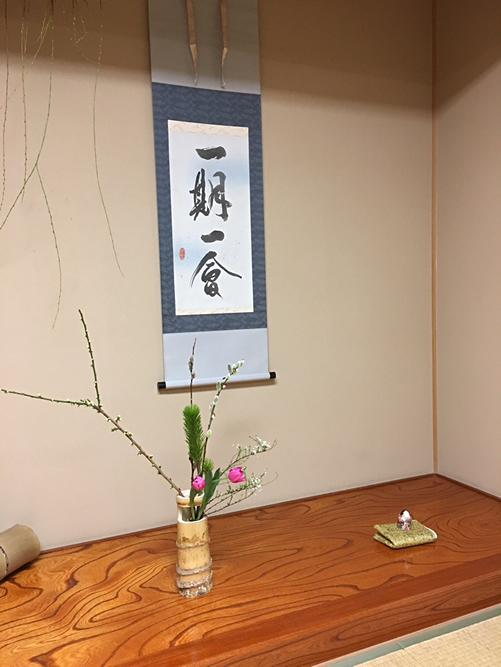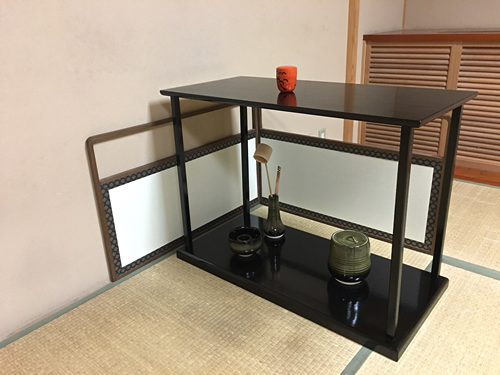Posted by TOKYO MATCHA SELECTION - Chris Young (living in UK) on 4th Mar 2018
The Japanese tea ceremony, also known as 'cha-no-yu', has a very long history. It begins with the arrival of powdered tea (matcha) from China. In Japan, a sophisticated culture grew around matcha as it passed from the hands of Buddhist monks to those of the fashionable aristocracy. Through the influence of the famous tea master Sen no Rikyu, the tradition became associated with the aesthetic principles of 'wabi-sabi', gradually developing into the quiet, meditative art form it is today. While highly formalized, the tea ceremony is not all about reenacting a bygone age. Instead, it is about paying attention to the present moment and connecting with others through a simple act of hospitality.
Matcha was first introduced to Japan in the 12th century. At first, it was used in a Buddhist ceremonial context, later becoming a status symbol among the aristocracy. This re-appropriation is hardly surprising, since Japanese nobles of the time already considered tea-drinking to be the height of sophistication. In one medieval Japanese parlour game, guests had to identify famous teas in a blind tasting. Winners are supposed to have received lavish prizes.
Although it was introduced to Japan by monks, flashy displays around the serving of matcha were not unheard of. Most famous of all was the portable gilded tea room which Toyotomi Hideyoshi had built when he became Imperial Regent of Japan in 1585. However, Hideyoshi's all-gold style was almost certainly a one-off. Today, the humble and austere aesthetic known as 'wabi-sabi' is what most people associate with the Japanese tea ceremony.
The person most responsible for the enduring style of cha-no-yu was called Sen no Rikyu. Having studied Zen and the tea ceremony as a young man, Rikyu later served as tea master for Oda Nobunaga and his successor, Toyotomi Hideyoshi (the man with the golden tea room). In his later years, Rikyu focussed increasingly on an intimate, rustic style of ceremony. For this purpose, he designed tiny thatched huts like the one preserved at Myōki-an temple in Yamazaki.
By Culture Relics Foundation [Public domain],
via Wikimedia Commons]
(Fun fact: the pure waters from the hills of Yamazaki, which Rikyu famously treasured for tea making, later fed Japan’s first commercial whisky distillery. The world-famous Yamazaki Distillery is still operated by Suntory today.)
Rikyu believed that the tea ceremony should express appreciation of the imperfect, transitory nature of life as well as the beauty of ordinary objects. These ideas, both central to wabi-sabi, explain the prevalence of natural materials and asymmetric forms in traditional tea rooms and utensils.
There are several schools of tea ceremony alive in Japan today. Each teaches its own prescribed motions and techniques for preparing the tea room, handling the tea utensils, and offering and receiving a bowl of matcha. Tea ceremonies range from casual outdoor meetings to highly formal events lasting several hours. Such an event may even incorporate a traditional kaiseki meal.
Cha-no-yu emphasizes the unique, unrepeatable quality of each moment. The Japanese saying 'ichi-go ichi-e', meaning 'one time, one meeting', derives in fact from the teachings of Sen no Rikyu. For this reason, the person hosting the tea ceremony pays special attention to the time of year and the taste of his or her guests. Utensils are specially selected for the occasion. While the tea room is mostly unadorned, the host may choose a hanging scroll and seasonal flower arrangement to decorate the 'tokonoma', an alcove reserved exclusively for this purpose.

Although the gestures involved in the Japanese tea ceremony may appear formal and ritualized, they all serve a practical purpose. Furthermore, their order is designed to minimize movement, allowing guests to focus on their surroundings.


Let us take the preparation of the tea bowl or 'chawan' as an example. Before preparing the tea, the host fills the chawan with hot water and carefully soaks the tips of the tea whisk in it. The chawan is then emptied and dried again with a soft cloth. This procedure not only cleans and warms the chawan, but also softens the bamboo whisk, which will help to achieve a good foam. Drying the bowl is important, as this prevents the matcha from sticking and clumping together when it is added in the next step. Everything is indeed quite logical!
Over the years, artisans have designed many items specifically for use in the Japanese tea ceremony. Beyond the chawan and tea whisk, there are curved bamboo tea scoops, decorative tea caddies, teapots, cloths and various other accoutrements. And of course, since each ceremony is a once-in-a-lifetime event, cha-no-yu practitioners serve only the finest 'ceremonial grade' matcha to their guests. At TOKYO MATCHA SELECTION, we believe our Ceremonial Grade Organic Japanese Matcha is one of the best.
Please also enjoy browsing our beautiful range of teaware, which we hope will inspire you to discover the Japanese tea ceremony for yourself. Below is a small selection of our favourite pieces!
https://www.tokyo-matcha-selection.com/premium-m...
https://www.tokyo-matcha-selection.com/kakejiku-o...
https://www.tokyo-matcha-selection.com/standard-n...
https://www.tokyo-matcha-selection.com/rectangle-...
https://www.tokyo-matcha-selection.com/value-matc...
https://www.tokyo-matcha-selection.com/ceremonial...

Most often, the Japanese tea ceremony is performed in a purpose built space known as chashitsu (茶室) - popularly known in English as tea rooms. In keeping with traditional Japanese architecture, the main building material is wood, with shōji (障子) - paper screens - used to divide the space, and tatami (畳) flooring throughout. Tatami [...]

Manners in Japanese tea ceremony Japanese tea ceremony has many rules about a manner. Even just standing up, there is a manner. In Japanese tea ceremony, there are many steps just to give a tea for a guest. Each step has a manner. Besides, there are many sects of Japanese tea ceremony and each sect has [...]

The chance to enter the tea's world was I joined the Sado Matcha Tea Ceremony Club (Urasenke) of my university when I was 18 years-old. *I got omenjo (permission) of Urasenke at the university. I thought that Sado is fun as well as teas, after I graduated my university, I [...]